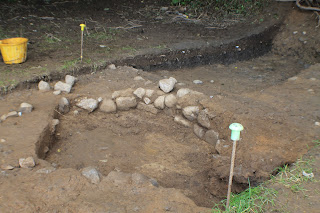 |
| Close-up of Christ Church Cathedral | | | | |
On Friday I walked across the way to Christ Church Cathedral,
constructed in the 12th century.
It stands within the grounds of old
medieval quarter and was built inside the formally walled city providing protection
from invaders. Saint Patrick’s Cathedral in contrast was
constructed outside the wall, because the common person attended mass there and
they would not have been able to pay the high tax required to live inside the
wall to cover the cost of the guards and the continual maintenance.

 |
| Detail of the "Foxy friars" floor tiles |
|
|
|
|
|
|
When the church became a priory the monks became very
wealthy because it was a place of pilgrimage and they developed the nickname “The
Foxy Friars”. The photos of the floor to the left show just one of tile arrangements depicting the foxy friars. The fox’s carry water holders made from calf
skin and staffs, just as pilgrims in the Middle Ages would have. The floor tiles are copies made in the 18th
century and are based on the original 12th century tiles.
 |
| Empty relic casket |
The church had several relics in its possession including a crow’s
ear given to Saint Patrick by Jesus, one thorn from the crown of thorns, a
rock from the mountain where the tablet was given, and a speaking cross. Pilgrims were typically charged high entrance
fees to view theses relics, which were believed to have heavenly powers. Despite the reformation the church was able to
retain one relic, the heart of its founder Laurence O’Toole. On the 3rd of March 2012 the relic
was stolen from the church during the hours of operation. The casket that house the relic heart remains
on the wall and they are hopeful that it will be returned. Unfortunately four sacred relics have been
stolen from Ireland this year.
When Henry the XIII broke
from Rome during the English reformation Christ Cathedral became an Anglican
church. He suppressed all the monasteries
and took all the money for himself. In 1562
the church fell down, the left wall is still lean’s but is structurally sound
and is the only original portion of the ground level church. The church is known as the “Whisky Church”
because in the 19
th century a wealthy distiller named Henry Roe
spent 20 million Euros to completely restore the church, rendering him bankrupt. He hired an English architect George Edmund
Street to complete the project. You can
compare the difference in the left and right walls where the restoration took
place.
 |
| Left side, the "leaning wall" |
 |
| Right side, completely restored wall |
 |
| The crypt |
The crypt was in the center of the old medieval city and all
of the old building were joined together underground. There
were also three taverns below the church as there was not enough space in the
medieval town. The names of the three
taverns were Paradise, Hell, and Purgatory with “instant forgiveness”
upstairs. Today you can grab a bite to
eat in the crypt at the Foxy Friars Coffee Shop.














